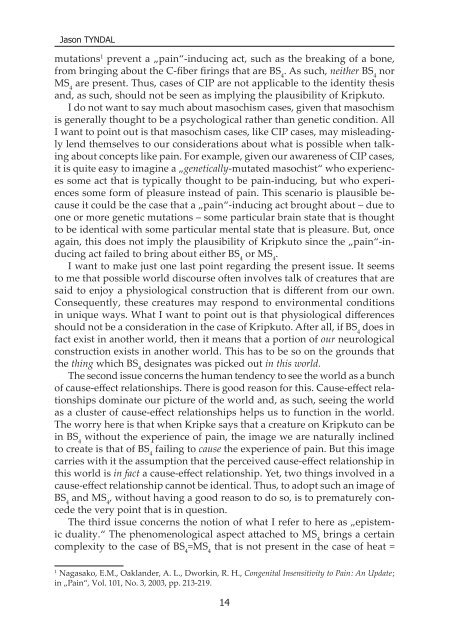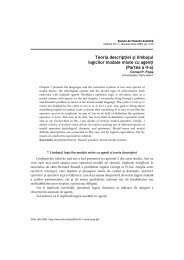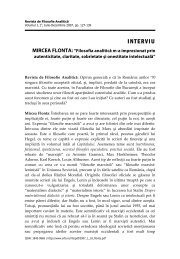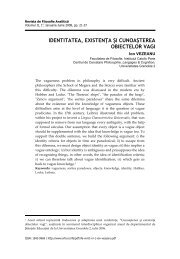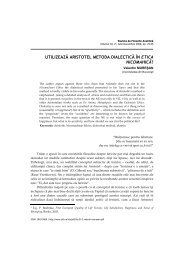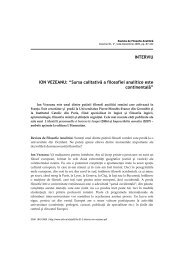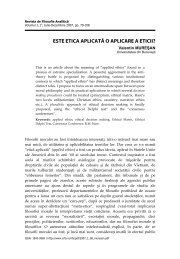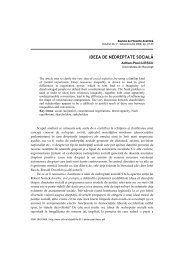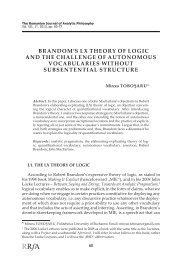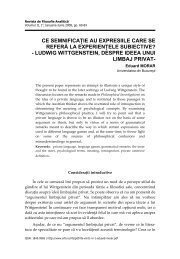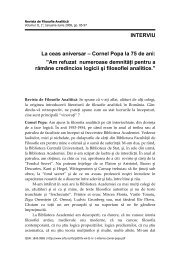AN ANALYSIS OF KRIpKE'S ARguMENT AgAINST THE IDENTITY ...
AN ANALYSIS OF KRIpKE'S ARguMENT AgAINST THE IDENTITY ...
AN ANALYSIS OF KRIpKE'S ARguMENT AgAINST THE IDENTITY ...
Create successful ePaper yourself
Turn your PDF publications into a flip-book with our unique Google optimized e-Paper software.
Jason TYNDAL<br />
mutations 1 prevent a „pain“‐inducing act, such as the breaking of a bone,<br />
from bringing about the C‐fiber firings that are BS 4<br />
. As such, neither BS 4<br />
nor<br />
MS 4<br />
are present. Thus, cases of CIP are not applicable to the identity thesis<br />
and, as such, should not be seen as implying the plausibility of Kripkuto.<br />
I do not want to say much about masochism cases, given that masochism<br />
is generally thought to be a psychological rather than genetic condition. All<br />
I want to point out is that masochism cases, like CIP cases, may misleadingly<br />
lend themselves to our considerations about what is possible when talking<br />
about concepts like pain. For example, given our awareness of CIP cases,<br />
it is quite easy to imagine a „genetically‐mutated masochist“ who experiences<br />
some act that is typically thought to be pain‐inducing, but who experiences<br />
some form of pleasure instead of pain. This scenario is plausible because<br />
it could be the case that a „pain“‐inducing act brought about – due to<br />
one or more genetic mutations – some particular brain state that is thought<br />
to be identical with some particular mental state that is pleasure. But, once<br />
again, this does not imply the plausibility of Kripkuto since the „pain“‐inducing<br />
act failed to bring about either BS 4<br />
or MS 4<br />
.<br />
I want to make just one last point regarding the present issue. It seems<br />
to me that possible world discourse often involves talk of creatures that are<br />
said to enjoy a physiological construction that is different from our own.<br />
Consequently, these creatures may respond to environmental conditions<br />
in unique ways. What I want to point out is that physiological differences<br />
should not be a consideration in the case of Kripkuto. After all, if BS 4<br />
does in<br />
fact exist in another world, then it means that a portion of our neurological<br />
construction exists in another world. This has to be so on the grounds that<br />
the thing which BS 4<br />
designates was picked out in this world.<br />
The second issue concerns the human tendency to see the world as a bunch<br />
of cause‐effect relationships. There is good reason for this. Cause‐effect relationships<br />
dominate our picture of the world and, as such, seeing the world<br />
as a cluster of cause‐effect relationships helps us to function in the world.<br />
The worry here is that when Kripke says that a creature on Kripkuto can be<br />
in BS 4<br />
without the experience of pain, the image we are naturally inclined<br />
to create is that of BS 4<br />
failing to cause the experience of pain. But this image<br />
carries with it the assumption that the perceived cause‐effect relationship in<br />
this world is in fact a cause‐effect relationship. Yet, two things involved in a<br />
cause‐effect relationship cannot be identical. Thus, to adopt such an image of<br />
BS 4<br />
and MS 4<br />
, without having a good reason to do so, is to prematurely concede<br />
the very point that is in question.<br />
The third issue concerns the notion of what I refer to here as „epistemic<br />
duality.“ The phenomenological aspect attached to MS 4<br />
brings a certain<br />
complexity to the case of BS 4<br />
=MS 4<br />
that is not present in the case of heat =<br />
1<br />
Nagasako, E.M., Oaklander, A. L., Dworkin, R. H., Congenital Insensitivity to Pain : An Update ;<br />
in „Pain“, Vol. 101, No. 3, 2003, pp. 213‐219.<br />
14


